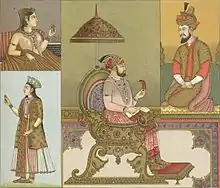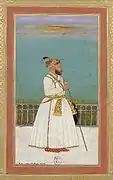Mughal clothing
Mughal clothing refers to clothing developed by the Mughals in the 16th, 17th and 18th centuries throughout the extent of their empire in the Indian subcontinent. It was characterized by luxurious styles and was made with muslin, silk, velvet and brocade.[2] Elaborate patterns including dots, checks, and waves were used with colors from various dyes including cochineal, sulfate of iron, sulfate of copper and sulfate of antimony were used.
Men traditionally wore long over-lapping coat known as Jama with patka sash tied around on the waist and " "Paijama" style pants were worn (leg coverings that gave the English word pajama) under the Jama. A "pagri" (turban) was worn on the head to complete the outfit. Women wore "shalwar", churidar", "dhilja", "garara", and "farshi". They wore much jewelry including earrings, nose jewelry, necklaces, bangles, belts, and anklets.[3] Other clothing types included: "peshwaz" style robes and "yalek" robes.
Pagri styles included: "Chau-goshia", in four segments, the dome shaped "qubbedar", "kashiti", "dupalli", embroidered "nukka dar", and embroidered and velvet "mandil".[3] Shoe styles included jhuti", "kafsh", "charhvan", "salim shahi" and "khurd nau" and were curved up at the front. Lucknow was known for its shoes and threading embroidery with gold and silver aughi during the era.[3] Mughal emperor turbans usually had turban ornaments on them. They were made of gold and precious gems such as rubies, diamonds, emeralds and sapphire.
Women's fashion
Beauty routine
Women of the imperial court practiced an elaborate beauty ritual consisting of the 16 celebrated rituals. [4]Eyebrows were arched symmetrically, Kajal applied to eyelids, the teeth were blackened with missi. Nath worn on the nose, studded with diamonds, was usually gifted to a bride by her husband. Betel leaf was used to redden the lips, sweeten breath and as deodorant. Princesses always decorated hands and feet red with mehendi, despite the obscene cost as it was also used as a remedy for skin irritations.[5][6]
%253F_LACMA_M.81.271.7.jpg.webp)
Jewellery
The Mughal period was one of the most popular eras of jewelry making, which is well-documented through chronicles and paintings. In fact the earlier Mughal paintings indicate that the era of Akbar's reign gave anew life into the art, crafting a range of exotic designs. The Mughals contributed in almost all fields of development of jewelry. The use of jewelry was an integral part of the lifestyle, be it the king, men or women or even the king's horse. Women were known to have as many as 8 complete sets of jewelry. Popular ornaments included two-inch-wide armlets worn above the elbows, bracelets or pearls at the wrist stacked high enough to impede access to the pulse, many rings (with the mirror ring worn on the right thumb customary for nearly all the inhabitants of the Zenana), strings of pearls (as many as 15 strings at a time), metal bands or strings of pearls at the bottom of their legs, and ornaments hanging in the middle of the head in the shape of star, sun, moon, or a flower.[5]
Turban jewelry was considered a privilege of the Emperor. The constant change in the influences from Europe can be clearly witnessed in the design of the turban jewelry. Akbar stuck to Iranian trends of the time by keeping a feather plume upright at the very front of the turban. Jahangir initiated his own softer style with the weighed down plume with a large pearl. By the time of Aurangzeb, this form became more ubiquitous. Turbans were usually heavily set with jewels and fixed firmly with a gem set kalangi or aigrette. Some of the popular head ornaments worn by men were Jigha and Sarpatti, Sarpech, Kalgi, Mukut, Turra and Kalangi. Women also adorned a variety of head ornaments such as Binduli, Kotbiladar, Sekra, Siphul, Tikka and Jhumar. In addition to these, the braid ornaments constituted an important part of women's head ornaments.[7]
Ear ornaments were also quite popular during the Mughal times. Mughal paintings have represented earrings quite often. Ear ornaments were worn by both men and women. Mor-Bhanwar, Bali, Jhumkas, Kanphool and Pipal patra or papal patti are some of the known earrings from the period. Neck ornaments of different kinds of pearls and precious stones were worn by men and women. Some of the neck ornaments for men included Latkan, amala necklace as well as Mala. Neck ornaments formed an important part of jewelry of women also and included Guluband, Hans, Har and Hasuli. Nose ornaments were worn solely by women. It appears that nose ornaments appeared in India around the last part of the 16th century initiated by Mughals. The variety of nose ornaments worn by women during the Mughal times constituted phul, besar, laung, balu, nath and Phuli.[7]
Dress
Owing to the relative isolation of the ladies in court, due to the Purdah, fashion in the early days of the empire adhered to traditional dress of Khurasan and Persia. In time, the social and diplomatic relationships between the Mughal Dynasty and the rest of India (Rajputana in particular), led to more exchange in accoutrements.[8] Noble women in the court of Babur or Humayun would have begun their outfits with wide loose pants, painted or stripped. Their upper body was covered in loose garments fastened at the neck or with "V"-shaped necklines. Other articles of clothing included the Yalek: a tightly fitting nearly floor length vest, buttoned in the front, with the chest accentuated, in both short and long sleeve varieties.
With the addition of Rajput princesses during the reign of Akbar, Hindu clothing came to influence the court. The wives and consorts began to dress similarly, regardless of religion. Often the ladies wore multiple layers of clothing, with a tight fitting bodice that stopped short of the navel. The peshwaz, fashionable as a men's garment for a time and later adopted by the women, was added on top. The length hit the knees or lower, the waist fastened closely, and the neckline was in a "V" shape. The opening at the front of the peshwaz would have been decorated in gold. Their lower half were covered either in tight pants (tunban or izar), or in la hengu, which itself was styled like a lungi attached at the ends and a band sewn into the top. Muslim women favored the pants style, and Hindu women, the skirt. In either style, the drawstrings were decorated at length with pearls and jewels.[8]
Only the costliest clothes of cotton, silk or wool were used. In the zenana, there were multiple costume changes a day, and often an outfit would be worn only once and then given away. The garments themselves were very thin, weighing less than an ounce each, with gold lace added and “muslin so fine as to be almost transparent.”[5] This may account for the breasts occasionally seen in Mughal miniature painting. The head was covered with gold cloths or turbans with feathers. Long gowns (qaba) or kashmiri shawl were used in cold weather.[6] Jamawars were suits of wool with flowers interwoven with wool or silk. Patterned and bejeweled shoes, with distinctively sharp upward curling points and worn down heels were fashionable.[5]
Textiles
Fabrics of the time included wild goat’s hair cloth (tus) and pashmina, light and warm wool. Silks were often embroidered with gold and silver thread and embellished with laces. Any and all of these cloths were regularly scented with rose water. Shawls were reportedly so thin they could pass through a finger ring. The various muslins had poetic names like ab-i-rawan, meaning "running water", and daft hawa, meaning "woven air". Each garment would wear out after a single use.[6]
 Late 17th century portrait of Fírúz Jang Khán, ruler of Bijapur
Late 17th century portrait of Fírúz Jang Khán, ruler of Bijapur Late 19th century "Costume of India - Moguls" picture depicting Mogul woman (upper left), Mogul Emperor Farrukhsiyar (center) died 1719, and Emperor Humayun (upper right), died in 1556
Late 19th century "Costume of India - Moguls" picture depicting Mogul woman (upper left), Mogul Emperor Farrukhsiyar (center) died 1719, and Emperor Humayun (upper right), died in 1556 Vizier Qamar ud-Din circa 1735
Vizier Qamar ud-Din circa 1735 Portrait of "Mogul" father with his children in Delhi (Shepherd & Robertson) circa 1863
Portrait of "Mogul" father with his children in Delhi (Shepherd & Robertson) circa 1863
See also
References
- Man's Robe (Jama) with Poppies https://www.metmuseum.org/art/collection/search/448247
- what did Mughals wear? DK find out
- Mughal dress Josbd
- Azer Ansari, Mohd (1997). The Harem of the Great Mughals (Part II). Amol Publications. pp. 65–68.
- Lal, K.S. (1988). The Mughal Harem. New Delhi: Aditya Prakashan. pp. 121–123. ISBN 8185179034.
- The Mughal World. New Delhi: Penguin Books India. 2007. pp. 139–142. ISBN 9780143102625.
|first1=missing|last1=(help) - Syed, Dr. Nafisa Ali (2015). Mughal Jewellery. India: Partridge. pp. 21–23. ISBN 978-1-4828-4271-5 – via open edition.
- Azer Ansari, Mohd. (1997). "The Harem of the Great Mughals (Part II)". In Taher, Mohamed (ed.). Mughal India: Part I. Encyclopaedic survey of Islamic culture. 9. New Delhi: Amol Publications. pp. 65–68. OCLC 258368756.
Further reading
- Roe, T., & Foster, William. (1899). The embassy of Sir Thomas Roe to the court of the Great Mogul, 1615-1619 : As narrated in his journal and correspondence (Works issued by the Hakluyt Society ; 2nd ser., no. 1). London: Printed for the Hakluyt society
- Bernier, F., Brock, Irving, & Constable, Archibald. (1968). Travels in the Mogul empire, A. D. 1656-1668. (A rev. and improved [2d] ed. based upon Irving Brock's translation, by Archibald Constable.. ed.). Delhi: S. Chand.
- Manucci, N., & Irvine, William. (1981). Storia do Mogor; or, Mogul India, 1653-1708. Cornell: Oriental Books Reprint Corp.
_with_Poppies_MET_DT11765.jpg.webp)